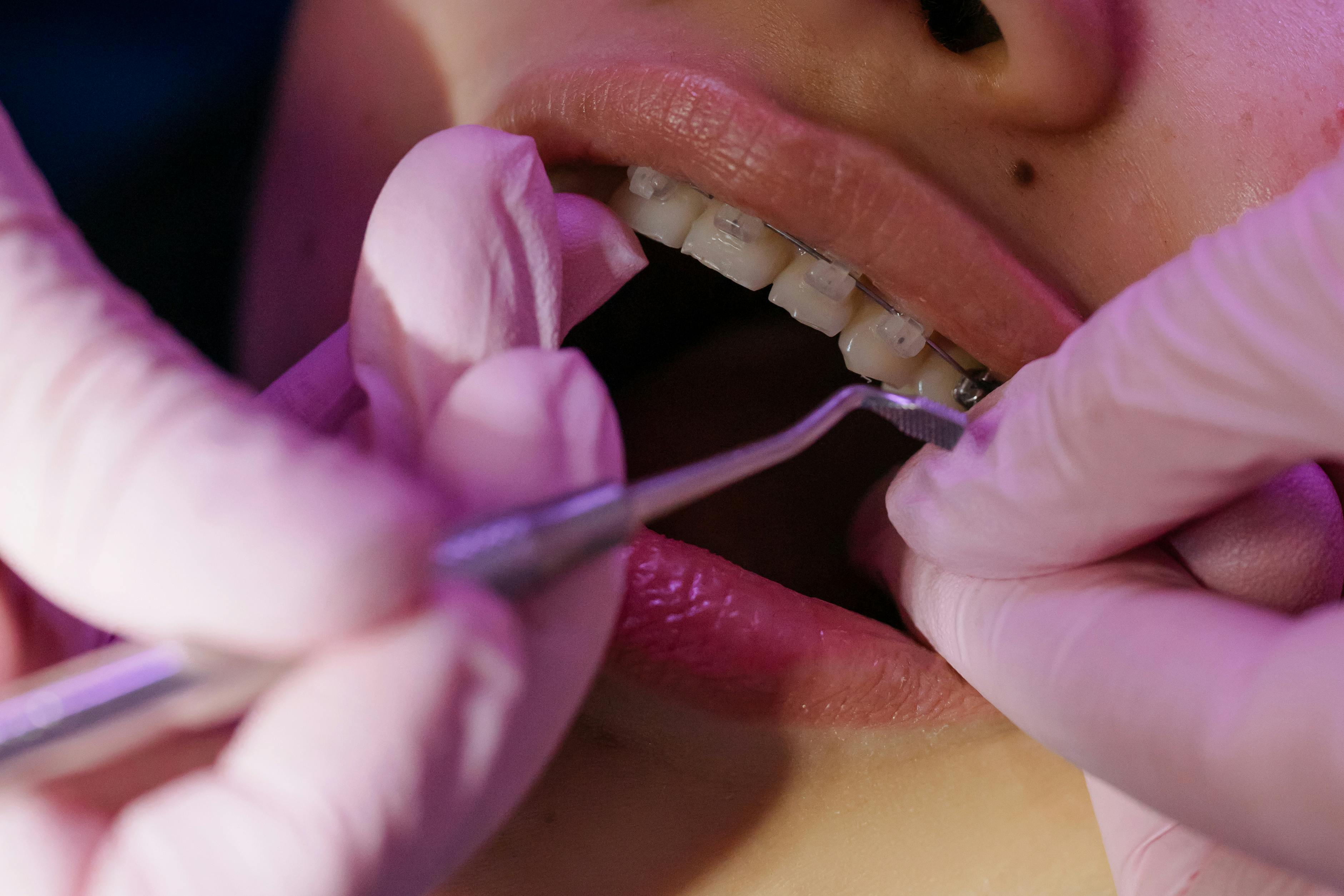Smile designing is the process of improving the appearance of a person's smile through various cosmetic dental treatments. It involves an evaluation of the patient's teeth, gums, lips, and overall facial appearance to create a customized treatment plan to achieve the desired smile.
It is a cosmetic treatment done by a cosmetic dentist that focuses on improving the appearance of your smile through certain procedures such as dental veneers, composite bonding, teeth whitening and gum recontouring. People suffering from dental problems like decaying teeth, loosening of teeth, stains, and bacterial plaque usually opt for this makeover treatment. Some factors taken into consideration for this treatment include: facial appearance and skin tone, gums and lips.
The process of smile designing may involve a range of treatments such as teeth whitening, dental veneers, dental crowns, orthodontics, gum contouring, and more. Our goal at Dent Heal is to create a natural-looking and aesthetically pleasing smile that complements the patient's facial features and enhances their self-confidence.
The shape of the face can have an impact on the appearance of the teeth, as well as the overall balance and harmony of the face. Here are some factors:
Facial symmetry: A symmetrical face often has balanced and proportionate teeth that complement each other. Conversely, an asymmetrical face can cause teeth to appear uneven or misaligned.
The goal of smile designing is to find symmetry even in asymmetry and give the patient a smile suited to their facial symmetry by attempting to mask what might be asymmetric.
Facial structure: The shape and size of the jaw and cheekbones can also affect the appearance of the teeth. A prominent jawline or high cheekbones can give the impression of a wider or fuller smile, while a smaller jaw or flatter cheekbones can make the teeth look narrower or crowded.
Also a more squarish face would look in sync with squarish shaped teeth, a rounder, delicate looking face would look in sync with rounded off teeth and a tapered face would look in sync with slightly tapered or triangular teeth.
Lips and mouth shape: The shape of the lips and mouth can also impact the appearance of the teeth.
Patient psychology: An assessment of the patient’s emotional and psychological state is interwoven with the esthetic evaluation. The key here is to establish a rapport with the patient. Patients seeking esthetic enhancement often experience shame, both about the ‘defects’ for which they are consulting you and the desire for cosmetic change itself. Shame about perceived physical defects, particularly if those defects are the result of the patient’s negligence, such as poor dental hygiene, may be a powerful deterrent to seeking an esthetic consultation in the first place. Shame may also pose a significant obstacle to the patient revealing thoughts and ideas they fear would evoke disapproval by the dentist.
We strive to create a safe environment, in which the patient’s fears of self expression are minimized. A non-judgmental and empathic stance, conveyed through tone and posture, is critical to the dentist gaining a clear understanding of the patient’s motivation for esthetic treatment and their expectations of outcome. The most important tool the dentist has in conducting an effective consultation is the dentist herselves. Interpersonal skills is as important as technical expertise in putting a patient at ease and gaining their trust. Two of the open-ended questions in the esthetic evaluation section are also useful in evaluating the patient’s psychological readiness and appropriateness for treatment.
They are:
A. If there was anything you could change about your smile, what would that be?
Some aspects that the smile design treatment encounters are:
Teeth colour- discolored or stained teeth may make you look aged and dull, while a well-shaped bright set of teeth leaves you with a perfect smile;
Alignment and spacing-uneven broken, overlapping teeth or teeth which have gaps in between can be evenly aligned and straightened with the help of improved veneers.
Missing tooth treatment- in case of a missing or cracked tooth, the treatment provides tooth implants which leaves you with a confident smile;
Get Fuller lips, smile and cheeks- the treatment not only focuses on your teeth, but also makes your lips and cheek look good so that you get a perfect makeover look;
Tooth proportion and smile line- in order to make your smile look flawless, the orthodontist or cosmetic surgeon would examine if your teeth are in correct proportion, or the imaginary smile line following the edges of your upper teeth is in proportion with the curve of your lower lips.
B. History of esthetic change
If you as a patient have had any dental veneers, composites or orthodontic treatment before, it is important to inform your dentist about it for improved communication as this will help the dentist to understand what about the previous treatment left you feeling dissatisfied.
The above analysis and a few more questions from the dentist, can lead to a better understanding of what the patient wants to achieve from this treatment. The dentist must then be able to achieve the result the patient wants while also keeping functional requirements in mind. The patient must be informed that the goal is to give the patient aesthetically pleasing results that they perceive as aesthetic but within the functional limitations of the lips, the tongue, opposing teeth, the chewing pattern, facial symmetry and other factors.
Sex of the patient, the age of the patient and the personality of the patient, are significant factors that contribute to how to design a smile.
For example : as we age, the shade of our teeth naturally becomes more yellow due to the wearing off of the top most white layer of the tooth, enamel. To replicate this natural biological change , it is preferable to select a shade based on the age of the patient.
How to select the right dentist for the job?
To get started with smile designing or while looking for cosmetic dentist near me or dental veneers near me, it's important to consult with a qualified cosmetic dentist or a prosthodontist who can evaluate your dental health, discuss your goals, and recommend the right approach. With modern dental technology and techniques, smile designing can be a relatively quick and painless process that can dramatically improve the appearance of your smile. See the dentists prior work, good cosmetic dentist usually document their cases and would be glad to show you their work . You can check their work in their social media profiles and furthermore ask them questions about their processes and techniques to get an insight as to how meticulous or skilled they are.
Designing with Dental veneers- FAQS
Dental veneers are thin, custom-made shells made of materials such as porcelain or composite resin that are designed to cover the front surface of a tooth to improve its appearance. Veneers are a popular cosmetic dental treatment used to address a variety of dental issues, such as discolored, misshapen, or chipped teeth.
Based on the material used to fabricate the veneers, they are of two types, Composite Veneers and Porcelain Veneers. Composite veneers are made of a biocompatible resin material and are often fabricated chair-side. On the other hand Porcelain veneers are made of another biocompatible material ceramic and are lab-made.
Composite veneers are made of a resin-based material. While they are a quick fix as they can be fabricated chair-side and are also cheaper, but composite veneers get stained very easily with food colours like turmeric, coffee, etc. Composite veneers can also chip off very easily and may lead to broken veneers in a few years. On the other hand, the Ceramic veneers are lab-made and require a longer time to fabricate. Irrespective of the cost and time taken to fabricate ceramic veneers, they are better option as they are stronger, donot stain easily, are durable and look more aesthetic as compared to composite veneers. At Dent Heal, we suggest the patient to go for porcelain veneers as they are a more durable and a better option for the aesthetics.
The process of getting veneers typically involves 4-5 visits to the dentist. During the initial visit, we evaluate the patient's dental health, discuss their goals and requirements, and make impressions of the teeth along with photos and videos required to plan and design the smile to the patient’s specifications. Once a treatment plan is formulated, the next step involves prepping the patients teeth and taking a final impression of the prepped teeth to start custom fabricating the veneers, this is the longest of all appointments and can last for 1-3 hrs depending on the number of teeth being veneered.
Our ceramic team works with cutting edge technology and the best ceramic powders in the market to create life-like and highly esthetic results.
Once the veneers are ready, which usually take 5-7 working days, we call the patient for a trial to assess the look and feel of the veneers, trial involves multiple check points where we check for fit, shade under different lighting, phonetics, speech and overall comfort. If satisfactory, we go ahead and bond them to the front surface of the teeth using a special dental adhesive.
With proper care and maintenance, dental veneers can last for many years ( avg 15 years) and can provide a long-lasting and effective solution to cosmetic dental concerns.
Brushing two times each day for two minutes, flossing daily, and wearing a night guard are great ways to protect the veneers. It is also adviced to avoid eating very hard foods like nuts, chikki, etc. with the front veneers. The patient is adviced to get a professional cleaning done every 6 months for the care and maintenance of the veneers.
Throughout the process, we keep the patient informed and involved, explaining each step of the process and addressing any concerns or questions the patient may have. This can help to ensure that the patient feels comfortable and confident throughout the procedure and is more likely to be satisfied with the final results.
>p?In addition to verbal communication, we also use visual aids such as photographs or digital imaging to help the patient better understand the procedure and visualize the expected results. This can be especially helpful for patients who are anxious or unsure about the process of getting dental veneers.






